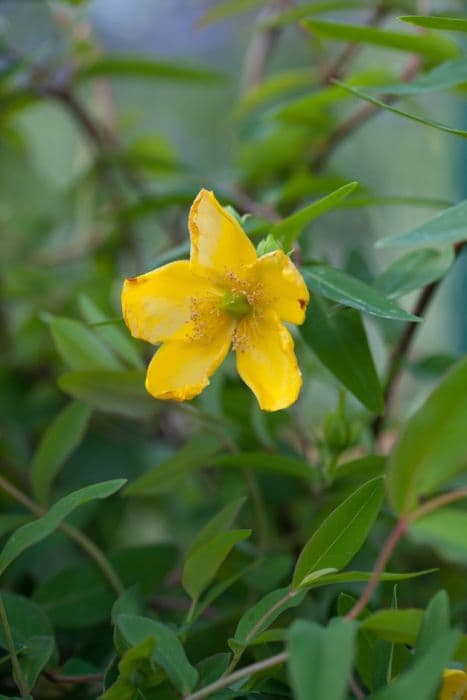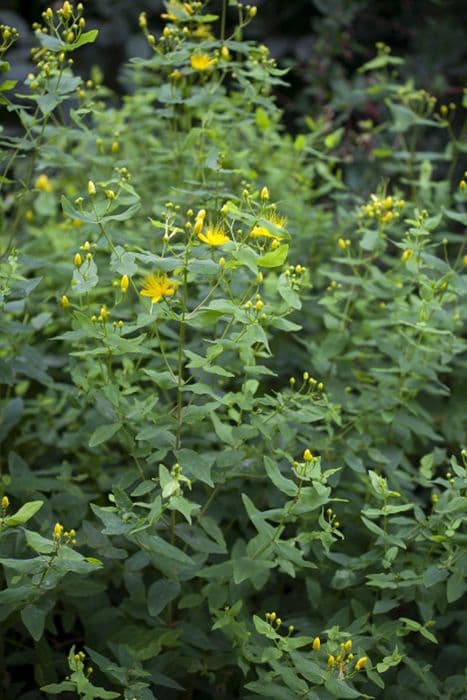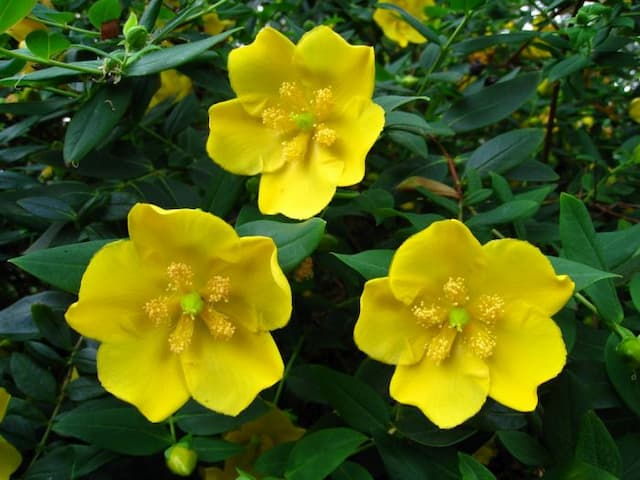St. John's Wort Hypericum patulum

ABOUT
Hypericum patulum, commonly known as the Gold Cup St. John's Wort, is a shrub that features a bushy, rounded shape with dense, woody branches. Its leaves are a vibrant, glossy green and are arranged in an opposite manner along the branches, displaying a broad oval shape with rounded tips. The foliage may exhibit a slight blue-green tinge in certain light conditions. The most distinguishing characteristic of this plant is its bright yellow flowers, which boast a profusion of showy, stamen-like structures in the center, creating a frilly, pompom-like effect. These abundant blossoms form in clusters and are renowned for their exuberant and long-lasting blooming period. The petals are oval and somewhat asymmetrical, with delicate black dots along their margins that add to the plant's ornamental appeal. After the flowering period, the plant produces small, berry-like fruits that offer additional visual interest throughout the changing seasons. The fruits are initially a greenish shade, maturing to a reddish color. Overall, the Gold Cup St. John's Wort is praised for its cheerful and vibrant demeanor, which can brighten any garden space. Its combination of lush foliage and radiant flowers make it a popular choice for gardeners and landscapers seeking a plant with strong aesthetic appeal.
About this plant
 Names
NamesFamily
Hypericaceae
Synonyms
Goldencup St. John's Wort, Yellow Rose of Sharon, Shrubby St. John's Wort
Common names
Hypericum patulum Thunb.
 Toxicity
ToxicityTo humans
The plant known as Hypericum patulum, commonly referred to as St. John's Wort, is not typically considered poisonous to humans. However, it contains compounds such as hyperforin and hypericin which can have toxic effects, particularly if consumed in large quantities. The most common symptoms of St. John's Wort poisoning in humans include gastrointestinal distress, such as nausea, vomiting, and diarrhea. In severe cases, it may cause confusion, agitation, fatigue, dizziness, and increased sensitivity to sunlight. For individuals on certain medications, particularly those related to depression (as St. John's Wort can interfere with serotonin levels), it is advisable to avoid ingesting this plant as it can interact with the drugs and have adverse effects such as serotonin syndrome. It is also contraindicated during pregnancy and lactation.
To pets
St. John's Wort (Hypericum patulum) is mildly toxic to pets. If a pet ingests parts of this plant, they may experience mild gastrointestinal upset, such as vomiting or diarrhea. In some cases, pets may also show signs of depression or lethargy. More concerning is the phototoxicity associated with Hypericum species; when pets ingest significant amounts of the plant and are exposed to sunlight, they may develop skin irritations or photosensitivity, which can result in redness, itching, or blistering of the skin. It is advisable to monitor the animal and consult a veterinarian if symptoms are observed following ingestion.
 Characteristics
CharacteristicsLife cycle
Perennials
Foliage type
Semi-deciduous
Color of leaves
Green
Flower color
Yellow
Height
3 feet (0.91 meters)
Spread
3 feet (0.91 meters)
Plant type
Shrub
Hardiness zones
5
Native area
Asia
Benefits
 General Benefits
General Benefits- Ornamental beauty: Hypericum patulum, commonly known as the St. John's Wort, adds aesthetic value to gardens with its bright yellow flowers and dense, shrubby form.
- Low maintenance: Once established, it requires minimal care, making it a convenient choice for gardeners of all skill levels.
- Drought tolerance: It can survive with limited water supply after establishment, making it suitable for xeriscaping and dry climate gardens.
- Wildlife attraction: The flowers attract pollinators such as bees and butterflies, supporting local ecosystems and biodiversity.
- Ground cover: Its dense growth habit can help prevent soil erosion and suppress weeds when used as ground covering plant.
- Sun tolerance: It thrives in full sun, making it ideal for sunny spots in the garden that might be challenging for other plants.
 Medical Properties
Medical Properties- Antidepressant: Hypericum patulum is a relative of Hypericum perforatum, also known as St. John's Wort, which has been used for its potential antidepressant properties.
- Antimicrobial: Extracts from Hypericum species have been studied for antimicrobial effects against various pathogens.
- Anti-inflammatory: The plant may contain compounds with anti-inflammatory effects, which could be beneficial in reducing inflammation.
- Antiviral: Hypericum species have been investigated for their potential antiviral properties, particularly against certain strains of viruses.
- Wound healing: Traditionally, some Hypericum species have been applied topically to promote wound healing.
 Air-purifying Qualities
Air-purifying QualitiesThis plant is not specifically known for air purifying qualities.
 Other Uses
Other Uses- St. John's Wort can be used as a natural fabric dye, yielding various shades of yellow, green, or brown depending on the mordant used.
- The flowers and seed pods of St. John's Wort can be used in floral arrangements, both fresh and dried, for their aesthetic appeal.
- This plant's dense and shrubby growth habit makes it suitable for use as a privacy hedge in gardens and landscapes.
- In some traditional practices, St. John's Wort has been hung over religious icons or in windows on St. John's Day to ward off evil spirits.
- Due to its bright yellow flowers and appealing shape, St. John's Wort is often planted for ornamental purposes in public parks and gardens.
- The essential oil extracted from St. John's Wort is sometimes used in perfumery, for its subtle, woody scent.
- Gardeners sometimes use St. John's Wort as a companion plant to attract beneficial insects that prey on garden pests.
- The plant can be an ingredient in potpourri mixes, contributing to a pleasant aroma and adding a touch of color.
- As an important nectar source, St. John's Wort is planted to attract and support local bee populations and other pollinators.
- In certain cultures, the plant is associated with midsummer festivities and is used to decorate homes during this time.
Interesting Facts
 Feng Shui
Feng ShuiThe plant St. John's Wort is not used in Feng Shui practice.
 Zodiac Sign Compitability
Zodiac Sign CompitabilityThe plant St. John's Wort is not used in astrology practice.
 Plant Symbolism
Plant Symbolism- Protection: Hypericum patulum, commonly known as St. John's Wort, has been associated with warding off evil spirits and protecting against negative forces.
- Healing: This plant has a long history of medicinal use, symbolizing the healing of physical and emotional wounds.
- Light and Sun: St. John's Wort blooms around the time of summer solstice and is often tied to the symbolism of light and the power of the sun, representing brightness and positive energy.
- Strength: Due to its robust nature and ability to thrive in less than ideal conditions, St. John's Wort represents resilience and strength.
- Good Health: The plant’s therapeutic properties make it a symbol of good health and well-being.
- Happiness and Cheer: The bright yellow flowers of St. John's Wort are seen as a symbol of joy, happiness, and bringing cheer to one's life.
 Water
WaterThe St. John's Wort should be watered deeply once a week, ensuring that the soil is moist but not waterlogged. During the growing season, you may need to water every three to four days especially if the weather is particularly hot or dry. It is important to provide about one to one and a half gallons of water per week for an established plant in a garden setting. Adjustments should be made during rainy periods by reducing the amount of supplemental water provided. Always check the soil moisture before watering to avoid overwatering which can lead to root rot.
 Light
LightSt. John's Wort thrives best in full sunlight to partial shade. It prefers a spot that receives at least six hours of direct sunlight on a daily basis. A location with morning sunlight and afternoon shade is beneficial, especially in regions with intensely hot summer sun, to prevent scorching of the leaves.
 Temperature
TemperatureSt. John's Wort is hardy in a range of temperatures and can survive minimum temperatures down to around 0 degrees Fahrenheit. They prefer growing in a climate where the average daytime temperature is between 60 and 70 degrees Fahrenheit. Ensure that it is not exposed to extreme cold without protection as it can damage or kill the plant.
 Pruning
PruningPrune St. John's Wort to maintain shape and promote bushier growth. Pruning is best done in early spring before new growth begins. Cut back about a quarter to a third of the oldest stems to the ground each year. This helps rejuvenate the plant and encourages new, healthy growth.
 Cleaning
CleaningAs needed
 Soil
SoilThe Gold Coin plant, also known as Hypericum patulum, thrives in well-draining soil with a slightly acidic to neutral pH of around 5.5 to 7. A soil mix comprising equal parts garden loam, peat, and perlite or sand creates an ideal environment for growth, ensuring good aeration and proper moisture retention.
 Repotting
RepottingGold Coin plants should generally be repotted every two to three years to prevent root-bound conditions and replenish nutrients in the soil. Younger or faster-growing plants may require more frequent repotting. Always use fresh, appropriate soil mix during repotting.
 Humidity & Misting
Humidity & MistingThe Gold Coin plant prefers moderate humidity levels, typical of many household environments. While it can tolerate lower humidity, it thrives best when the relative humidity is between 40-50%.
 Suitable locations
Suitable locationsIndoor
Place in bright, indirect light, avoid overwatering.
Outdoor
Full sun to part shade, protect from harsh winters.
Hardiness zone
6-9 USDA
 Life cycle
Life cycleHypericum patulum, commonly known as goldencup St. John's wort, begins its life cycle as a seed that germinates in spring when soil temperatures and moisture levels are appropriate. After germination, seedlings emerge and develop into juvenile plants with characteristic opposite, oval-shaped leaves and a woody stem over the growing season. As the plant matures, it enters the flowering stage, usually in early to mid-summer, producing bright yellow flowers with numerous stamens in a showy display that can last until late summer. After pollination, typically by insects, the flowers develop into capsule-like fruits, which contain numerous tiny seeds that are dispersed by various means, including wind and animal movement. Throughout its lifetime, the plant will experience periods of vegetative growth and dormancy, typically in sync with the seasonal cycle, with growth slowing down or pausing during colder months. Hypericum patulum is perennial; therefore, it can survive for several years, with the cycle of flowering and seed production repeating annually until the end of its lifespan.
 Propogation
PropogationPropogation time
Spring-Early Summer
Propogation: Hypericum patulum, commonly known as the Goldcup St. John's Wort, is typically propagated by semi-hardwood cuttings. The optimal time for taking cuttings is during the late summer, as the new growth begins to mature and harden slightly. A cutting should be about 4 to 6 inches (10 to 15 centimeters) long, including several leaf nodes. The lower leaves are removed, and the cut end of the cutting is dipped in rooting hormone powder to encourage root development. The prepared cutting is then inserted into a well-drained rooting medium such as a mix of peat and perlite. To retain humidity around the cutting, creating a mini-greenhouse effect, it's often covered with a plastic bag or placed in a propagator. Root formation usually occurs within a few weeks, after which the rooted cuttings can be transplanted into individual pots.









